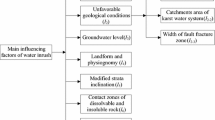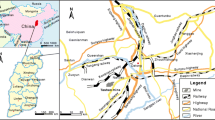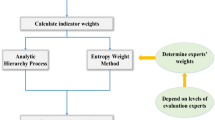Abstract
The complex hydrogeological conditions of China’s coal fields and the frequent water inrush accidents there seriously threaten the safe mining of coal. A new risk evaluation model for water inrushes from seam floors was constructed by combining the established evaluation index system with set pair analysis (SPA), thereby integrating quantitative and qualitative indexes. The resultant model reflects both the factors affecting water inrush from the seam floor and the uncertainty in the parameter values for those factors. To demonstrate the value of this model, the risk of water inrush from the seam floor was assessed for the working face of a mine in Tongzi county, Guizhou province, China. The prediction obtained from the model conformed to the actual conditions. Moreover, the methodology provides a basis for water inrush risk assessment from seam floors.
Zusammenfassung
Die komplexen hydrogeologischen Bedingungen von Kohlelagestätten und die häufigen Wassereinbrüche aus dem Liegenden stellen eine ernsthafte Gefährdung für den sicheren Abbau in Kohlebergwerken in China dar. Viele Faktoren beeinflussen Wassereinbrüche aus dem Liegenden. Die Parameterwerte für diese Faktoren sind aber mit einigen Unsicherheiten behaftet. Um dieses Problem zu bewältigen, wurde ein neues Modell zur Risikobewertung von Wassereinbrüchen aus dem Liegenden entwickelt. Es kombiniert das etablierte System von Bewertungsindizes mit der set-pair-Analyse (SPA) und integriert quantitative und qualitative Indizes. Das Model spiegelt sowohl die Faktoren wider, die Wassereinbrüche aus dem Liegenden beeinflussen als auch die Unsicherheit der Parameterwerte dieser Faktoren. Um den Nutzen des Models zu demonstrieren, wurde das Risiko des Wassereinbruchs aus dem Liegenden für den Arbeitsbereich eines Bergwerks im Verwaltungsbezirk Tongzi in der Provinz Guizhou in China bewertet. Die Ergebnisse zeigen, dass die Modelprognose zu den tatsächlichen Bedingungen passt. Die Methodik stellt die Basis für eine Risikobewertung von Wassereinbrüchen aus dem Liegenden dar.
抽象
煤田复杂水文地质条件和频繁煤层底板突水事故严重威胁煤矿安全。煤层底板突水受多因素控制,各因素同时受多种不确定性影响。为解决煤层底板突水问题,评价因子系统引入集对分析(SPA),建立了一种新的底板突水危险性评价模型。模型既能体现底板突水因素作用又能反应各因素的不确定性影响。评价了贵州桐梓县煤矿某工作面底板突水风险,模型预测结果与实际情况一致。研究方法为煤层底板突水评价问题解决提供了研究基础。
Resumen
Las complejas condiciones hidrogeológicas de los campos de carbón y los frecuentes accidentes de irrupción de agua a través del piso de la veta, amenazan la seguridad del trabajo en las minas de carbón en China. Numerosos factores controlan la irrupción de agua desde los pisos de las vetas; no obstante, el rango de los valores para estos parámetros está sujeto a cierta incerteza. Para solucionar estos problemas, un nuevo modelo de evaluación de riesgo se construyó mediante la combinación de un sistema de índices de evaluación aceptado con un análisis de conjunto de pares (SPA) integrando índices cuali y cuantitativos. El modelo resultante refleja tanto los factores que afectan la irrupción de agua como la incerteza en los valores de esos factores. Para demostrar la validez del modelo, se relevó el riesgo de irrupción de agua desde el piso de veta en una cara de trabajo de una mina en Tongzi, provincia de Guizhou, China. Los resultados muestran que la predicción obtenida a través del modelo concuerda con las condiciones reales. Aún más, la metodología proporciona una base para el relevamiento de riesgo de irrupciones de agua a través de los pisos de las vetas.

Similar content being viewed by others
References
Cao QK, Zhao F (2011) Research on expert system for risk assessment of water inrush from coal floor and its application. J Chin Coal Soc 36(4):634–637 (in Chinese)
Dong SN (2010) Some key scientific problems on water hazards that frequently occur in China’s coal mines. J Chin Coal Soc 35(1):66–71 (in Chinese)
Dong DL, Sun WJ, Xi S (2012) Water-inrush assessment using a GIS-based Bayesian network for the 12–2 coal seam of the Kailuan Donghuantuo coal mine in China. Mine Water Environ 31(2):138–146
Engineering Geological Handbook Editorial Board (1992) Engineering geological handbook. China Architecture & Building Press, Beijing (in Chinese)
Guan ET (2011) Water outburst coefficient and mine water disaster prevention and control. Coal Eng 47(1):46–48 (in Chinese)
Jin HZ, Cheng HZ, Jia DX (2006) Fuzzy set pair analysis method and its application in multi-objective transmission network planning. T Circuits Syst 5(1):135–141
Li B, Chen YL (2015) Risk assessment of coal floor water inrush from underlying aquifers based on GRA–AHP and its application. Geotech Geol Eng 34(1):143–154
Li B, Wu Q (2015) An analysis of parameters sensitivity for vulnerability assessment of groundwater inrush during mining from underlying aquifers based on variable weight model. J Min Safe Eng 32(6):911–917 (in Chinese)
Li PY, Qian H, Wu JH (2011) Application of set pair analysis method based on entropy weight in groundwater quality assessment-a case study in Dongsheng City, northwest China. J Chem 8(2):851–858
Li B, Wu Q, Chen YL, Wang GL, Xue L (2016) Multi-factor evaluation for the water yield properties of coal floor aquifers, based on GIS. Water Pract Technol 11(1):77–85
Meng ZP, Yi W, Lan H, Wang M (2009) Water inrush characteristics of Fangezhuang coalmine field in Kailuan and its geological condition analysis of water inrush from coal seam floor. Chin J Rock Mech Eng 28(2):228–236 (in Chinese)
Sun YJ, Xu ZM, Dong QH, Liu SD, Gao RB, Jiang YH (2008) Forecasting water disaster of a coal mine under the Xiaolangdi reservoir. China Univ Min Technol 18(4):516–520
Sun WJ, Zhou WF, Jiao J (2016) Hydrogeological classification and water inrush accidents in China’s coal mines. Mine Water Environ 35(2):214–220
Tan C, Song Y, Che H (2017) Application of set pair analysis method on occupational hazard of coal mining. Saf Sci 92:10–16
Tao LM, Huang DC, Liang XK (2012) Research on subjective trust model based on set pair analysis for P2P grid. J Comput Info Syst 8(17):7417–7424
Wang CX, Wang HM (2004) Thinking about theories and practices on mine water control. Coal Geol Explor 32(11):100–103 (in Chinese)
Water Resources Department of the People’s Republic of China (2014) Standard for engineering classification of rock mass. China Planning Press, Beijing (in Chinese)
Wei C, Dai XY, Ye SF, Guo ZY, Wu JP (2016) Prediction analysis model of integrated carrying capacity using set pair analysis. Ocean Coast Manag 120:39–48
Wu Q, Li ZY (2002) Mine flood prevention. China Univ of Mining and Technology Press, Xuzhou (in Chinese)
Wu Q, Liu Y, Yang L (2011) Using the vulnerable index method to assess the likelihood of a water inrush through the floor of a multi-seam coal mine in China. Mine Water Environ 30(1):54–60
Wu Q, Li B, Chen YL (2016) Vulnerability assessment of groundwater inrush from underlying aquifers based on variable weight model and its application. Water Resour Manag 30(10):3331–3345
Yan F, Xu KL (2017) Application of a cloud model-set pair analysis in hazard assessment for biomass gasification stations. Plos One 12(1):1–17
Yao BH, Bai HB, Zhang BY (2012) Numerical simulation on the risk of roof water inrush in Wuyang Coal Mine. Int J Min Sci Technol 22(2):237–277
Zeng YF, Wu Q, Liu SQ, Zhai YL, Zhang W, Liu Y (2016) Vulnerability assessment of water bursting from Ordovician limestone into coal mines of China. Environ Earth Sci 75(22):1431
Zhao KQ (1994) Set Pair analysis and its preliminary application. Explor Nat 13(47):67–72 (in Chinese)
Zhao KQ (1995) The application of uncertainty systems theory of set pair analysis. Explor Nat 14(54):87–88 (in Chinese)
Acknowledgements
This research was financially supported by China’s National Natural Science Foundation (Grants 41430318, 41702270, and 41572222) and National Scientific and Technical Support Program (Grants 2016YFC0801800 and 2012BAB12B03), Guizhou Province’s Science and Technology Agency Foundation [qian ke he LH zi(2014)7617] and Geological Exploration Fund (Guizhou karst groundwater system functions sustainable utilization), the Guizhou University Introducing Talents Research Foundation (2014–61), the Joint Open Foundation of the Key Laboratory of the Institute of Hydrogeology and Environmental Geology, and the Chinese Academy of Geological Sciences (Grant KF201612).
Author information
Authors and Affiliations
Corresponding author
Rights and permissions
About this article
Cite this article
Bo, L., Qiang, W., xian-qian, D. et al. Risk Analysis Model of Water Inrush Through the Seam Floor Based on Set Pair Analysis. Mine Water Environ 37, 281–287 (2018). https://doi.org/10.1007/s10230-017-0498-5
Received:
Accepted:
Published:
Issue Date:
DOI: https://doi.org/10.1007/s10230-017-0498-5




